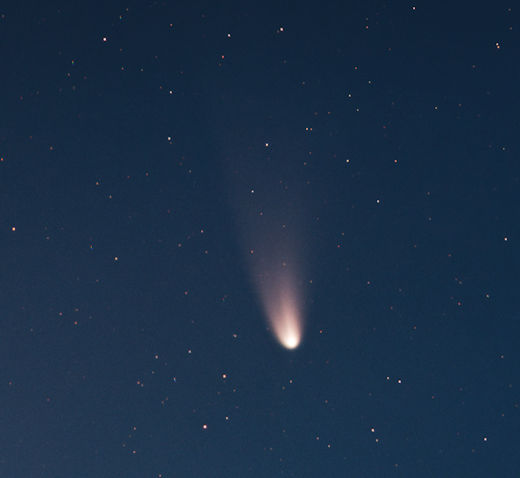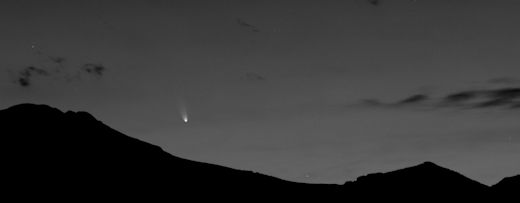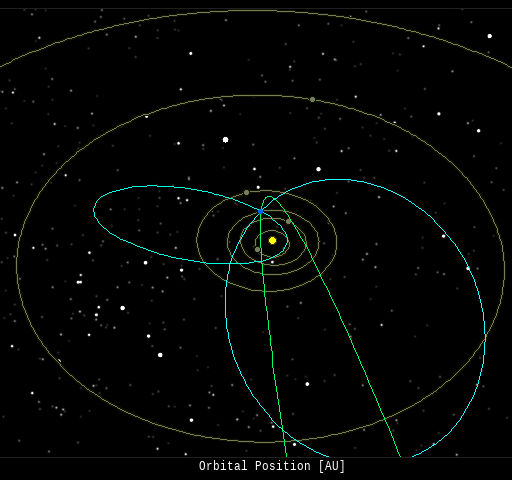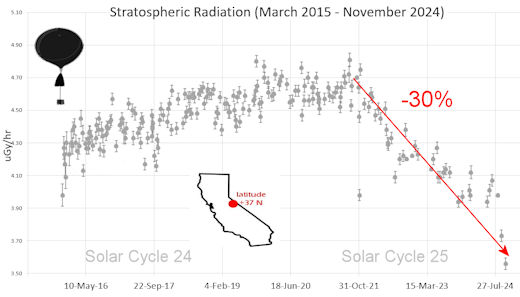This is an AI Free Zone! Text created by Large Language Models is spreading rapidly across the Internet. It's well-written, but frequently inaccurate. If you find a mistake on Spaceweather.com, rest assured it was made by a real human being. | | |
WHAT HAPPENED TO THE CMEs? Since Jan. 3rd, sunspot AR3947 has produced three X-flares and dozens of M-class solar flares. All that activity yielded zero significant CMEs. What happened? Flares and CMEs are two different aspects of exploding sunspots; they don't always happen at the same time. Dozens of flares with zero CMEs is a little unusual, but not unprecedented. The opposite can happen, too. AR3947 might suddenly start producing CMEs with no significant flares. It would certainly improve the aurora forecast. Solar flare alerts: SMS Text.
A BRIGHT COMET IS FALLING TOWARD THE SUN: Next week, Comet ATLAS (C/2024 G3) could outshine the planet Venus. It's falling toward the sun for a very close encounter (0.09 AU) on Jan. 13th. "If, by some miracle, the comet survives the intense thermal stress, it could become visible to the naked eye for observers in the southern hemisphere," says Lionel Majzik, who sends this picture from Chile:

"I photographed the comet at sunrise on Dec. 31st," says Majzik. "It was only about 6 degrees above the horizon. A fan-shaped prominent dust tail could be seen in the waxing glow of the rising sun."
Three days after Majzik's photo, Comet ATLAS experienced an outburst, abruptly brightening by +2 magnitudes. Many astronomers feared it might be breaking apart. However, Nick James of the British Astronomical Association thinks it might be okay.
"The sudden jump in brightness on Jan. 2nd, first reported by Terry Lovejoy, was significant," says James. "This could have been an early sign of disintegration, but since then the comet is still brightening. It looks as if this outburst has not been fatal."
Indeed, James himself photographed the comet apparently intact on Jan 4th:

"This is a dawn photo from Rio Hurtado, Chile," says James. "The comet was only 16 degrees from the sun, easy to photograph despite being very low in the morning sky"
The big day is Jan. 13th, when the comet swoops only 0.09 AU from the sun. If current trends hold, its magnitude should increase to around -5 (twice as bright as Venus). "It might even be visible in the daytime sky, but the sun will be only 5 degrees away," notes James. "Observing with the sun so nearby is dangerous and should only be attempted with great care."
SOHO coronagraphs will pick up the comet starting Jan. 11th. That will give us a preview of what to expect two days later. Until then, read "Prospects for C/2024 G3 (ATLAS)" by Nick James for observing tips--and stay tuned!
more images: from Michael Mattiazzo of Swan Hill, Australia; from Alan C Tough using a remote telescope in Rio Hurtado Valley, Chile
Realtime Space Weather Photo Gallery
Free: Spaceweather.com Newsletter
GIFTS FROM THE EDGE OF SPACE: A New Year of balloon launches is beginning, and we need to buy helium! You can help by puchasing a gift from the Earth to Sky Store. It's filled with unique items that have flown to the edge of space onboard cosmic ray research balloons.

These unique gifts have flown above 99.7% of Earth's atmosphere, experiencing space-like blasts of cosmic rays, extreme cold, and a wild ride parachuting back to Earth after the balloon explodes. Even Amazon doesn't carry items this far out.
Don't forget to enter coupon code "SOLARMAX2025" at checkout for a 15% holiday discount. All profits support STEM space weather research.
Far Out Gifts: Earth to Sky Store
All sales support hands-on STEM education
Realtime Comet Photo Gallery
Free: Spaceweather.com Newsletter
Realtime Aurora Photo Gallery
Free: Spaceweather.com Newsletter
Every night, a network of
NASA all-sky cameras scans the skies above the United States for meteoritic fireballs. Automated software maintained by NASA's Meteoroid Environment Office calculates their orbits, velocity, penetration depth in Earth's atmosphere and many other characteristics. Daily results are presented here on Spaceweather.com.
On Jan 06, 2025, the network reported 7 fireballs.
(7 sporadics)

In this diagram of the inner solar system, all of the fireball orbits intersect at a single point--Earth. The orbits are color-coded by velocity, from slow (red) to fast (blue). [Larger image] [movies]
Potentially Hazardous Asteroids (
PHAs) are space rocks larger than approximately 100m that can come closer to Earth than 0.05 AU. None of the known PHAs is on a collision course with our planet, although astronomers are finding
new ones all the time.
On January 7, 2025 there were 2349 potentially hazardous asteroids.
 |
Recent & Upcoming Earth-asteroid encounters: | Asteroid | Date(UT) | Miss Distance | Velocity (km/s) | Diameter (m) |
| 2024 YR9 | 2025-Jan-02 | 8.7 LD | 20.7 | 25 |
| 2025 AO1 | 2025-Jan-02 | 1.4 LD | 8.1 | 10 |
| 2024 YF7 | 2025-Jan-02 | 5.1 LD | 13.6 | 25 |
| 2024 YS9 | 2025-Jan-02 | 4.1 LD | 21.2 | 10 |
| 2025 AE2 | 2025-Jan-02 | 19.1 LD | 9.9 | 42 |
| 2024 XP10 | 2025-Jan-02 | 19.8 LD | 8.4 | 39 |
| 2025 AA2 | 2025-Jan-02 | 3.3 LD | 13.6 | 21 |
| 2025 AC | 2025-Jan-02 | 0.4 LD | 4.3 | 6 |
| 2024 YC9 | 2025-Jan-03 | 3.4 LD | 8.7 | 14 |
| 2025 AB | 2025-Jan-03 | 0.4 LD | 11.6 | 13 |
| 2025 AE | 2025-Jan-03 | 16.4 LD | 16.7 | 25 |
| 2025 AO | 2025-Jan-03 | 1.2 LD | 9.8 | 6 |
| 2025 AX1 | 2025-Jan-03 | 2.9 LD | 14.6 | 15 |
| 2024 YL1 | 2025-Jan-03 | 6.2 LD | 4.8 | 12 |
| 2025 AN2 | 2025-Jan-03 | 1.8 LD | 8.5 | 14 |
| 2024 YL7 | 2025-Jan-04 | 12.7 LD | 7.3 | 30 |
| 2021 AO4 | 2025-Jan-04 | 6.9 LD | 15.1 | 11 |
| 2024 YG13 | 2025-Jan-04 | 1.9 LD | 11.8 | 14 |
| 2024 YU1 | 2025-Jan-04 | 5.9 LD | 7.3 | 32 |
| 2025 AC2 | 2025-Jan-04 | 9.4 LD | 6.3 | 30 |
| 2025 AZ1 | 2025-Jan-04 | 6.8 LD | 13.9 | 11 |
| 2024 YX9 | 2025-Jan-04 | 5.7 LD | 11.2 | 15 |
| 2024 YT3 | 2025-Jan-05 | 10.8 LD | 7.1 | 18 |
| 2020 BC6 | 2025-Jan-05 | 9.6 LD | 22.2 | 248 |
| 2024 YY21 | 2025-Jan-06 | 14.5 LD | 5.2 | 15 |
| 2024 YW3 | 2025-Jan-06 | 5.6 LD | 12.3 | 33 |
| 2024 YZ9 | 2025-Jan-07 | 9.5 LD | 8.5 | 34 |
| 2024 YA10 | 2025-Jan-08 | 8.9 LD | 12 | 21 |
| 2024 BM1 | 2025-Jan-08 | 11.5 LD | 9.1 | 22 |
| 2024 PT5 | 2025-Jan-09 | 4.7 LD | 1 | 12 |
| 2024 YD13 | 2025-Jan-09 | 14.6 LD | 7.3 | 24 |
| 2023 OS3 | 2025-Jan-09 | 19.9 LD | 3.1 | 10 |
| 2024 YW9 | 2025-Jan-09 | 2.7 LD | 7.8 | 19 |
| 2008 AU28 | 2025-Jan-09 | 12.6 LD | 10.8 | 39 |
| 2024 YD5 | 2025-Jan-10 | 15.1 LD | 7.2 | 20 |
| 2012 UK171 | 2025-Jan-11 | 10.7 LD | 6.4 | 46 |
| 2025 AF1 | 2025-Jan-11 | 4.7 LD | 4.9 | 11 |
| 2024 YZ12 | 2025-Jan-12 | 3.2 LD | 8.6 | 19 |
| 2022 EE6 | 2025-Jan-13 | 15.5 LD | 8.7 | 45 |
| 2025 AS | 2025-Jan-14 | 16.1 LD | 9.2 | 46 |
| 2024 YX5 | 2025-Jan-14 | 11.6 LD | 10.6 | 25 |
| 2023 OS | 2025-Jan-15 | 16.6 LD | 10.9 | 48 |
| 2022 CE2 | 2025-Jan-16 | 11.1 LD | 13.3 | 120 |
| 2024 YF2 | 2025-Jan-17 | 4.4 LD | 4.4 | 17 |
| 2025 AO2 | 2025-Jan-17 | 2 LD | 10.3 | 19 |
| 2025 AF | 2025-Jan-17 | 19.8 LD | 8.8 | 34 |
| 2022 OB5 | 2025-Jan-18 | 8.9 LD | 1.4 | 6 |
| 2024 YB10 | 2025-Jan-18 | 15.1 LD | 2.5 | 16 |
| 2024 WY70 | 2025-Jan-18 | 16.5 LD | 10.2 | 261 |
| 2024 YQ5 | 2025-Jan-19 | 17.6 LD | 5 | 29 |
| 2024 YY5 | 2025-Jan-26 | 12.5 LD | 2.4 | 14 |
| 2022 BX6 | 2025-Jan-28 | 19.7 LD | 14.3 | 24 |
| 2015 DJ155 | 2025-Jan-31 | 18.6 LD | 9.2 | 56 |
| 2018 RE3 | 2025-Feb-03 | 15.5 LD | 11.1 | 12 |
| 2022 AV4 | 2025-Feb-03 | 16.9 LD | 3.4 | 25 |
| 2002 CC14 | 2025-Feb-04 | 8.4 LD | 12.7 | 39 |
| 2016 CO248 | 2025-Feb-07 | 13.5 LD | 5.9 | 11 |
| 2020 GZ2 | 2025-Feb-07 | 17.7 LD | 8.9 | 9 |
| 2022 PK1 | 2025-Feb-07 | 15 LD | 11 | 33 |
| 2012 PB20 | 2025-Feb-09 | 3.5 LD | 4.3 | 37 |
| 2004 XG | 2025-Feb-16 | 15.6 LD | 9.1 | 54 |
| 2024 UD26 | 2025-Feb-16 | 16.8 LD | 9.3 | 250 |
| 2014 CE13 | 2025-Feb-18 | 15.2 LD | 18.4 | 55 |
| 2022 DG2 | 2025-Feb-19 | 11.5 LD | 10.4 | 7 |
| 2016 AX165 | 2025-Feb-20 | 14.9 LD | 9.2 | 89 |
| 2015 BK509 | 2025-Feb-25 | 9.4 LD | 14.6 | 119 |
| 2023 RW3 | 2025-Feb-25 | 7.4 LD | 5.1 | 18 |
| 535844 | 2025-Mar-05 | 9.6 LD | 7.9 | 149 |
Notes: LD means "Lunar Distance." 1 LD = 384,401 km, the distance between Earth and the Moon. 1 LD also equals 0.00256 AU. | | Cosmic Rays in the Atmosphere |
SPACE WEATHER BALLOON DATA: Almost once a week, Spaceweather.com and the students of Earth to Sky Calculus fly space weather balloons to the stratosphere over California. These balloons are equipped with sensors that detect secondary cosmic rays, a form of radiation from space that can penetrate all the way down to Earth's surface. Our monitoring program has been underway without interruption for 10 years, resulting in a unique dataset of in situ atmospheric measurements.
Latest results (Nov. 2024): Atmospheric radiation is decreasing in 2024. Our latest measurements in November registered a 10-year low:

What's going on? Ironically, the radiation drop is caused by increasing solar activity. Solar Cycle 25 has roared to life faster than forecasters expected. The sun's strengthening and increasingly tangled magnetic field repels cosmic rays from deep space. In addition, solar coronal mass ejections (CMEs) sweep aside cosmic rays, causing sharp reductions called "Forbush Decreases." The two effects blend together to bring daily radiation levels down.
.Who cares? Cosmic rays are a surprisingly "down to Earth" form of space weather. They can alter the chemistry of the atmosphere, trigger lightning, and penetrate commercial airplanes. According to a study from the Harvard T.H. Chan school of public health, crews of aircraft have higher rates of cancer than the general population. The researchers listed cosmic rays, irregular sleep habits, and chemical contaminants as leading risk factors. A number of controversial studies (#1, #2, #3, #4) go even further, linking cosmic rays with cardiac arrhythmias and sudden cardiac death.
Technical notes: The radiation sensors onboard our helium balloons detect X-rays and gamma-rays in the energy range 10 keV to 20 MeV. These energies span the range of medical X-ray machines and airport security scanners.
Data points in the graph labeled "Stratospheric Radiation" correspond to the peak of the Regener-Pfotzer maximum, which lies about 67,000 feet above central California. When cosmic rays crash into Earth's atmosphere, they produce a spray of secondary particles that is most intense at the entrance to the stratosphere. Physicists Eric Regener and Georg Pfotzer discovered the maximum using balloons in the 1930s and it is what we are measuring today.
| | The official U.S. government space weather bureau |
| | The first place to look for information about sundogs, pillars, rainbows and related phenomena. |
| | Researchers call it a "Hubble for the sun." SDO is the most advanced solar observatory ever. |
| | 3D views of the sun from NASA's Solar and Terrestrial Relations Observatory |
| | Realtime and archival images of the Sun from SOHO. |
| | information about sunspots based on the latest NOAA/USAF Active Region Summary |
| | current counts of failed and deployed Starlink satellites from Jonathan's Space Page. See also, all satellite statistics. |
| | Authoritative predictions of space junk and satellite re-entries |
| | from the NOAA Space Environment Center |
| | fun to read, but should be taken with a grain of salt! Forecasts looking ahead more than a few days are often wrong. |
| | from the NOAA Space Environment Center |
| | the underlying science of space weather |
 | Got a chipped or cracked windshield that prevents you from seeing space weather events while driving? Get windshield replacement from SR Windows & Glass with free mobile auto glass service anywhere in the Phoenix area. |
 | BestCSGOGambling is the best site for everything related to CSGO gambling on the web |
| | These links help Spaceweather.com stay online. Thank you to our supporters! |
| | | | | | |

